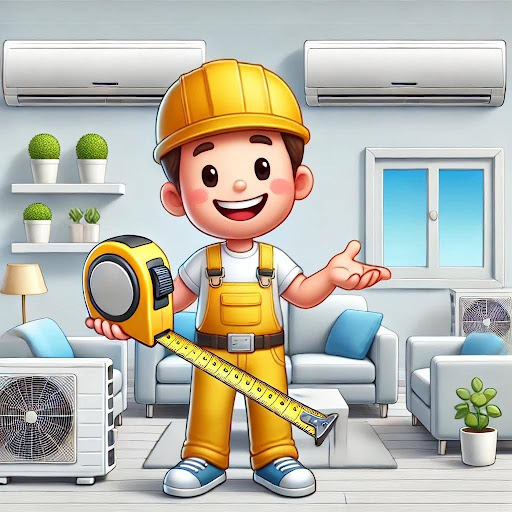No products in the cart.
When it comes to cooling your home, one of the most popular options these days is the ductless mini split air conditioner. These units are perfect for homes without ductwork, or for adding extra comfort to specific rooms. However, figuring out the right size for your mini split AC can feel a little tricky at first. Don’t worry though—we’re here to break it down for you in an easy, friendly way!
Looking for an all-in-one solution for your home? Check out our range of energy-efficient mini split air conditioning systems designed to provide seamless cooling without the hassle of ductwork.
Let’s dive into how to properly size your mini split system, answer some common questions, and help you avoid mistakes.
What is a Mini Split, and Why is Sizing So Important?
A mini split air conditioner has two main parts: an outdoor unit and one or more indoor units. These systems are energy-efficient, easy to install, and they don’t require ductwork, which is why they’re called “ductless.”
One of the key things to know about mini splits is that they come in different sizes, which are measured in BTUs (British Thermal Units). The right size BTU unit will efficiently cool your room without overworking itself, saving you energy and money. If you choose a unit that’s too small, it will constantly run to try to cool the space. If you choose one that’s too big, it will cool the room too quickly without removing humidity, which leaves the room feeling cold but uncomfortable.
How Do I Know What Size Mini Split I Need?
When it comes to selecting the right size, room size is the main factor. But don’t worry, you don’t
have to be a professional to get it right! Here’s a quick guide to help:
- Up to 300 square feet: 9,000 BTUs
- 300–500 square feet: 12,000 BTUs
- 500–750 square feet: 18,000 BTUs
- 750–1,000 square feet: 24,000 BTUs
If you’re wondering why the size of your room matters so much, it’s because the air conditioner needs enough power to handle the amount of air in the room. Larger spaces require more cooling power, while smaller rooms need less.
Thinking of installing a mini split for a larger space? Discover our Multi-Zone Mini Split Systems to cool multiple rooms efficiently.
Why a Bigger Unit Isn’t Always Better—But It Can Be
One thing you might wonder is, “Shouldn’t I just get a bigger unit to make sure it’s powerful enough?” That’s a good question, and while getting a larger unit can sometimes help, especially in extreme weather or crowded rooms, it’s important to know that most mini splits are inverters. This means they modulate up or down to meet the needs of the space. For example, a 12,000 BTU unit can actually cool about 20% more or 20% less when needed. This flexibility is perfect for spaces where the temperature fluctuates or when you have more people in the room. That being said, it’s often better to go slightly larger if you’re unsure, especially if the room gets lots of sun, has high ceilings, or isn’t well insulated. In these situations, a larger unit won’t overwork itself and will adjust to handle changes in temperature.
Find out how a bigger unit can improve comfort in sun-exposed spaces with our Expert AC Guide.
What if I Have Multiple Rooms to Cool?
If you’re looking to cool more than one room, a multi-zone mini split system is your best bet. These systems let you cool several rooms using one outdoor unit connected to multiple indoor units. Each room (or “zone”) can have its own temperature setting, which is great for homes where people have different preferences. For example, you can keep the living room cooler during the day and the bedroom cooler at night, without having to adjust one central unit.
When sizing for a multi-zone system, you’ll need to calculate the BTU needs for each room separately and ensure that the outdoor unit can handle the combined load.
Other Factors to Consider When Sizing a Mini Split
While room size is the biggest factor, there are a few other things that can affect the size of mini split you need:
- Ceiling height: If you have high ceilings, you’ll need more cooling power since there’s more air to cool.
- Sunlight: Rooms that get a lot of direct sunlight tend to get hotter, so they might need more BTUs to stay comfortable.
- Insulation: Well-insulated rooms hold onto cool air better, meaning you might be able to use a smaller unit.
- Room use: Rooms with lots of electronics (like a home office) or cooking (like a kitchen) generate more heat, so they may need a bit more cooling power.
Do Mini Splits Control Humidity?
Yes, and this is a big plus for ductless systems! Mini splits are also great humidity controllers, allowing you to set the exact humidity level you want. This is particularly important because humidity has a big effect on how comfortable a room feels. Even if the temperature is ideal, if it’s too humid, the room can feel stuffy.
Most mini split systems allow you to control both the temperature and the humidity, so you can set it up to match your comfort preferences perfectly.
Can I Install a Mini Split Myself?
It’s tempting to take on a mini split installation as a DIY project, but we recommend hiring a professional HVAC technician. A professional will ensure the unit is installed correctly, including running the necessary electrical wiring, refrigerant lines, and making sure it’s properly charged and calibrated. If you want your system to run smoothly and efficiently for years, getting expert help is the way to go.
Final Thoughts
Sizing your ductless mini split air conditioner correctly is essential to keeping your home comfortable and your energy bills low. By considering room size, usage, and other factors, you can make sure you pick the right unit for your needs. Remember, it’s often better to go slightly bigger to handle changing weather or larger crowds in the room. And if you’re cooling multiple rooms, a multi-zone system can make your life a lot easier.
If you’re unsure about sizing or installation, don’t hesitate to reach out to a professional for advice. Happy cooling!


